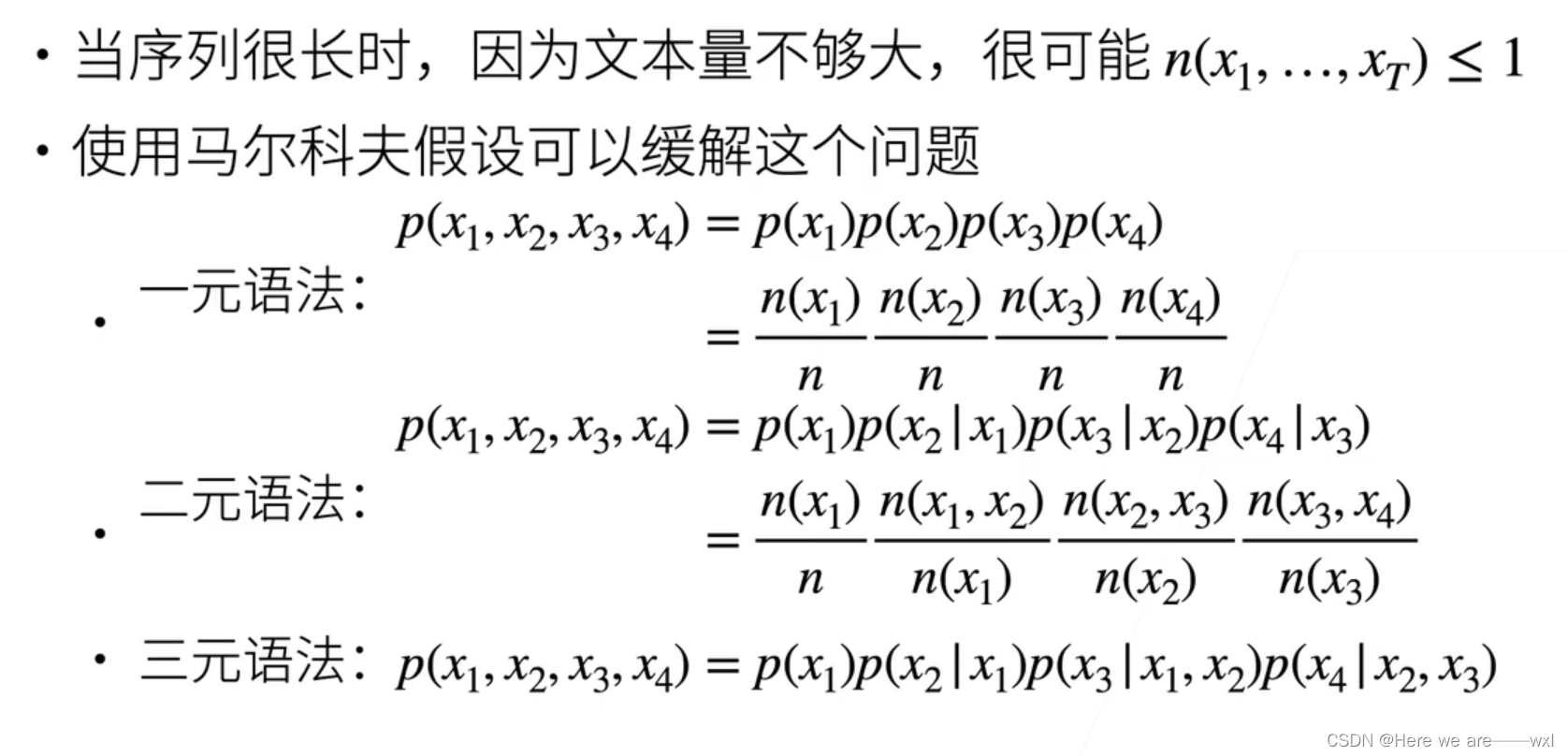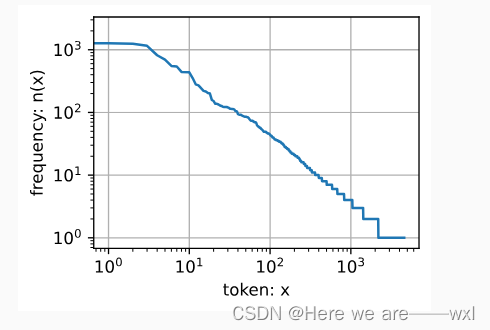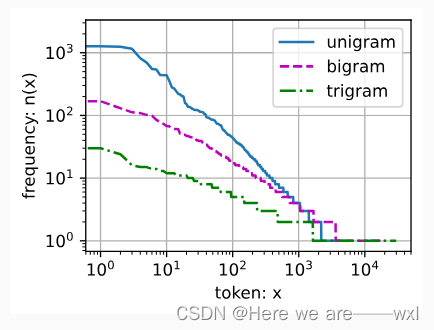之——nlp基础
目录
之——nlp基础
杂谈
正文
1.文本预处理
2.语言模型
3.语言模型实现
杂谈
在语言模型中,需要对文本进行预处理,进行数字化的一系列操作,而后才能进行网络的拟合。
以前的相关:词性判断
正文
1.文本预处理
将文本作为时序信息看待,前后的字词连贯性带来了时序信息。
文本预处理就是要怎么把这些字词变成我们能够训练的数据。
import collections
import re
from d2l import torch as d2l首先读取数据集:
d2l.DATA_HUB['time_machine'] = (d2l.DATA_URL + 'timemachine.txt','090b5e7e70c295757f55df93cb0a180b9691891a')def read_time_machine(): #@save"""将时间机器数据集加载到文本行的列表中"""with open(d2l.download('time_machine'), 'r') as f:lines = f.readlines()"""为了简单,除去字母外其他都变成空格,且都变成小写"""return [re.sub('[^A-Za-z]+', ' ', line).strip().lower() for line in lines]lines = read_time_machine()
print(f'# 文本总行数: {len(lines)}')
print(lines[0])
print(lines[10])
####
Downloading ../data/timemachine.txt from http://d2l-data.s3-accelerate.amazonaws.com/timemachine.txt...
"""文本总行数: 3221
the time machine by h g wells
twinkled and his usually pale face was flushed and animated the
"""这样得到的句子是没办法训练的,要变成单独的词元token来作为基本单元。以下是一些常用的基本单元:
def tokenize(lines, token='word'): #@save"""将文本行拆分为单词或字符词元"""if token == 'word':return [line.split() for line in lines]elif token == 'char':return [list(line) for line in lines]else:print('错误:未知词元类型:' + token)tokens = tokenize(lines)
for i in range(11):print(tokens[i])构建词汇表:
class Vocab: #@save"""文本词表"""def __init__(self, tokens=None, min_freq=0, reserved_tokens=None):if tokens is None:tokens = []if reserved_tokens is None:reserved_tokens = []# 按出现频率排序counter = count_corpus(tokens)self._token_freqs = sorted(counter.items(), key=lambda x: x[1],reverse=True)# 未知词元的索引为0self.idx_to_token = ['<unk>'] + reserved_tokensself.token_to_idx = {token: idxfor idx, token in enumerate(self.idx_to_token)}for token, freq in self._token_freqs:if freq < min_freq:breakif token not in self.token_to_idx:self.idx_to_token.append(token)self.token_to_idx[token] = len(self.idx_to_token) - 1def __len__(self):return len(self.idx_to_token)def __getitem__(self, tokens):if not isinstance(tokens, (list, tuple)):return self.token_to_idx.get(tokens, self.unk)return [self.__getitem__(token) for token in tokens]def to_tokens(self, indices):if not isinstance(indices, (list, tuple)):return self.idx_to_token[indices]return [self.idx_to_token[index] for index in indices]@propertydef unk(self): # 未知词元的索引为0return 0@propertydef token_freqs(self):return self._token_freqsdef count_corpus(tokens): #@save"""统计词元的频率"""# 这里的tokens是1D列表或2D列表if len(tokens) == 0 or isinstance(tokens[0], list):# 将词元列表展平成一个列表tokens = [token for line in tokens for token in line]return collections.Counter(tokens)vocab = Vocab(tokens)
print(list(vocab.token_to_idx.items())[:10])
"""
[('<unk>', 0), ('the', 1), ('i', 2), ('and', 3), ('of', 4), ('a', 5), ('to', 6), ('was', 7), ('in', 8), ('that', 9)]
"""这样,我们就把所有的词都数字化了:
for i in [0, 10]:print('文本:', tokens[i])print('索引:', vocab[tokens[i]])
"""
文本: ['the', 'time', 'machine', 'by', 'h', 'g', 'wells']
索引: [1, 19, 50, 40, 2183, 2184, 400]
文本: ['twinkled', 'and', 'his', 'usually', 'pale', 'face', 'was', 'flushed', 'and', 'animated', 'the']
索引: [2186, 3, 25, 1044, 362, 113, 7, 1421, 3, 1045, 1]
"""词元的类型是字符串,而模型需要的输入是数字,因此这种类型不方便模型使用。 现在,构建一个字典,通常也叫做词表(vocabulary), 用来将字符串类型的词元映射到从0开始的数字索引中。 我们先将训练集中的所有文档合并在一起,对它们的唯一词元进行统计, 得到的统计结果称之为语料(corpus)。 然后根据每个唯一词元的出现频率,为其分配一个数字索引。 很少出现的词元通常被移除(低于min_freq),这可以降低复杂性。 另外,语料库中不存在或已删除的任何词元都将映射到一个特定的未知词元“<unk>”。 我们可以选择增加一个列表,用于保存那些被保留的词元, 例如:填充词元(“<pad>”); 序列开始词元(“<bos>”); 序列结束词元(“<eos>”)。
所有的打包:
def load_corpus_time_machine(max_tokens=-1): #@save"""返回时光机器数据集的词元索引列表和词表"""lines = read_time_machine()tokens = tokenize(lines, 'word')vocab = Vocab(tokens)# 因为时光机器数据集中的每个文本行不一定是一个句子或一个段落,# 所以将所有文本行展平到一个列表中corpus = [vocab[token] for line in tokens for token in line]if max_tokens > 0:corpus = corpus[:max_tokens]return corpus, vocabcorpus, vocab = load_corpus_time_machine()
len(corpus), len(vocab)2.语言模型
语言模型的目标,预测整个文本序列出现的概率:

其应用:①做预训练、②生成文本,给定前面的对话,不断使用这一估计来生成新的后续文本、③判断哪个语言序列更合适。
基本的先验概率是基于词数的贝叶斯:

但如果特别长的句子,就会导致![]() ,特别小,所以引入马尔科夫思想,进行一定的简化:
,特别小,所以引入马尔科夫思想,进行一定的简化:

受限于复杂度与大小,一般会用二元或者三元。
3.语言模型实现
运用之前的词库,调用统计的freq,发现大多数其实都是stop words,就是大量出现,但没有太多意义的词:
import random
from mxnet import np, npx
from d2l import mxnet as d2lnpx.set_np()tokens = d2l.tokenize(d2l.read_time_machine())
# 因为每个文本行不一定是一个句子或一个段落,因此我们把所有文本行拼接到一起
corpus = [token for line in tokens for token in line]
vocab = d2l.Vocab(corpus)
vocab.token_freqs[:10]
"""
[('the', 2261),('i', 1267),('and', 1245),('of', 1155),('a', 816),('to', 695),('was', 552),('in', 541),('that', 443),('my', 440)]
"""可以可视化一下token图:
freqs = [freq for token, freq in vocab.token_freqs]
d2l.plot(freqs, xlabel='token: x', ylabel='frequency: n(x)',xscale='log', yscale='log')小部分的词占据了大部分的出现频率:

二元组合,用zip压缩下:
bigram_tokens = [pair for pair in zip(corpus[:-1], corpus[1:])]
bigram_vocab = d2l.Vocab(bigram_tokens)
bigram_vocab.token_freqs[:10]
"""
[(('of', 'the'), 309),(('in', 'the'), 169),(('i', 'had'), 130),(('i', 'was'), 112),(('and', 'the'), 109),(('the', 'time'), 102),(('it', 'was'), 99),(('to', 'the'), 85),(('as', 'i'), 78),(('of', 'a'), 73)]
"""
发现还是有很多stop words,而三元出现进一步的改观:
trigram_tokens = [triple for triple in zip(corpus[:-2], corpus[1:-1], corpus[2:])]
trigram_vocab = d2l.Vocab(trigram_tokens)
trigram_vocab.token_freqs[:10]
"""
[(('the', 'time', 'traveller'), 59),(('the', 'time', 'machine'), 30),(('the', 'medical', 'man'), 24),(('it', 'seemed', 'to'), 16),(('it', 'was', 'a'), 15),(('here', 'and', 'there'), 15),(('seemed', 'to', 'me'), 14),(('i', 'did', 'not'), 14),(('i', 'saw', 'the'), 13),(('i', 'began', 'to'), 13)]
"""
对比一下:
bigram_freqs = [freq for token, freq in bigram_vocab.token_freqs]
trigram_freqs = [freq for token, freq in trigram_vocab.token_freqs]
d2l.plot([freqs, bigram_freqs, trigram_freqs], xlabel='token: x',ylabel='frequency: n(x)', xscale='log', yscale='log',legend=['unigram', 'bigram', 'trigram'])

)
)











)




